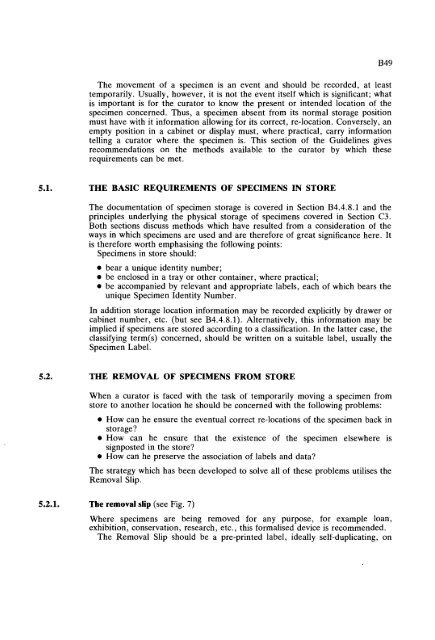GUIDELINES FOR THE CURATION OF GEOLOGICAL MATERIALS
GUIDELINES FOR THE CURATION OF GEOLOGICAL MATERIALS
GUIDELINES FOR THE CURATION OF GEOLOGICAL MATERIALS
Create successful ePaper yourself
Turn your PDF publications into a flip-book with our unique Google optimized e-Paper software.
The movement of a specimen is an event and should be recorded, at least<br />
temporarily. Usually, however, it is not the event itself which is significant; what<br />
is important is for the curator to know the present or intended location of the<br />
specimen concerned. Thus, a specimen absent from its normal storage position<br />
must have with it information allowing for its correct, re-location. Conversely, an<br />
empty position in a cabinet or display must, where practical, carry information<br />
telling a curator where the specimen is. This section of the Guidelines gives<br />
recommendations on the methods available to the curator by which these<br />
requirements can be met.<br />
<strong>THE</strong> BASIC REQUIREMENTS <strong>OF</strong> SPECIMENS IN STORE<br />
The documentation of specimen storage is covered in Section B4.4.8.1 and the<br />
principles underlying the physical storage of specimens covered in Section C3.<br />
Both sections discuss methods which have resulted from a consideration of the<br />
ways in which specimens are used and are therefore of great significance here. It<br />
is therefore worth emphasising the following points:<br />
Specimens in store should:<br />
bear a unique identity number;<br />
be enclosed in a tray or other container, where practical;<br />
be accompanied by relevant and appropriate labels, each of which bears the<br />
unique Specimen Identity Number.<br />
In addition storage location information may be recorded explicitly by drawer or<br />
cabinet number, etc. (but see B4.4.8.1). Alternatively, this information may be<br />
implied if specimens are stored according to a classification. In the latter case, the<br />
classifying term(s) concerned, should be written on a suitable label, usually the<br />
Specimen Label.<br />
<strong>THE</strong> REMOVAL <strong>OF</strong> SPECIMENS FROM STORE<br />
When a curator is faced with the task of temporarily moving a specimen from<br />
store to another location he should be concerned with the following problems:<br />
How can he ensure the eventual correct re-locations of the specimen back in<br />
storage?<br />
How can he ensure that the existence of the specimen elsewhere is<br />
signposted in the store?<br />
How can he preserve the association of labels and data?<br />
The strategy which has been developed to solve all of these problems utilises the<br />
Removal Slip.<br />
5.2.1. The removal slip (see Fig. 7)<br />
Where specimens are being removed for any purpose, for example loan,<br />
exhibition, conservation, research, etc., this formalised device is recommended.<br />
The Removal Slip should be a pre-printed label, ideally self-duplicating, on

















